What is a Food Service Director Cover Letter
A Food Service Director cover letter is a crucial document that accompanies your resume when applying for a Food Service Director position. It serves as your introduction to the hiring manager, providing a concise overview of your qualifications, skills, and experience. Unlike your resume, which lists your accomplishments, the cover letter gives you the opportunity to elaborate on your suitability for the role and express your enthusiasm for the position and the company. It’s your chance to make a strong first impression and differentiate yourself from other applicants by showcasing your personality and highlighting your unique value proposition. Writing a compelling cover letter can significantly increase your chances of landing an interview and ultimately securing the job.
Why is a Food Service Director Cover Letter Important
A well-crafted Food Service Director cover letter is important for several reasons. First, it allows you to personalize your application and demonstrate your genuine interest in the specific job and the organization. It enables you to connect your skills and experiences directly to the requirements outlined in the job description, showing the hiring manager that you understand the role and are a good fit. Second, it gives you the chance to address any potential gaps in your resume or explain any career transitions. Finally, a strong cover letter showcases your communication skills, writing ability, and attention to detail. These qualities are essential for a Food Service Director, who must communicate effectively with staff, vendors, and other stakeholders. A cover letter can be the deciding factor that sets you apart from other candidates.
Key Elements of a Food Service Director Cover Letter
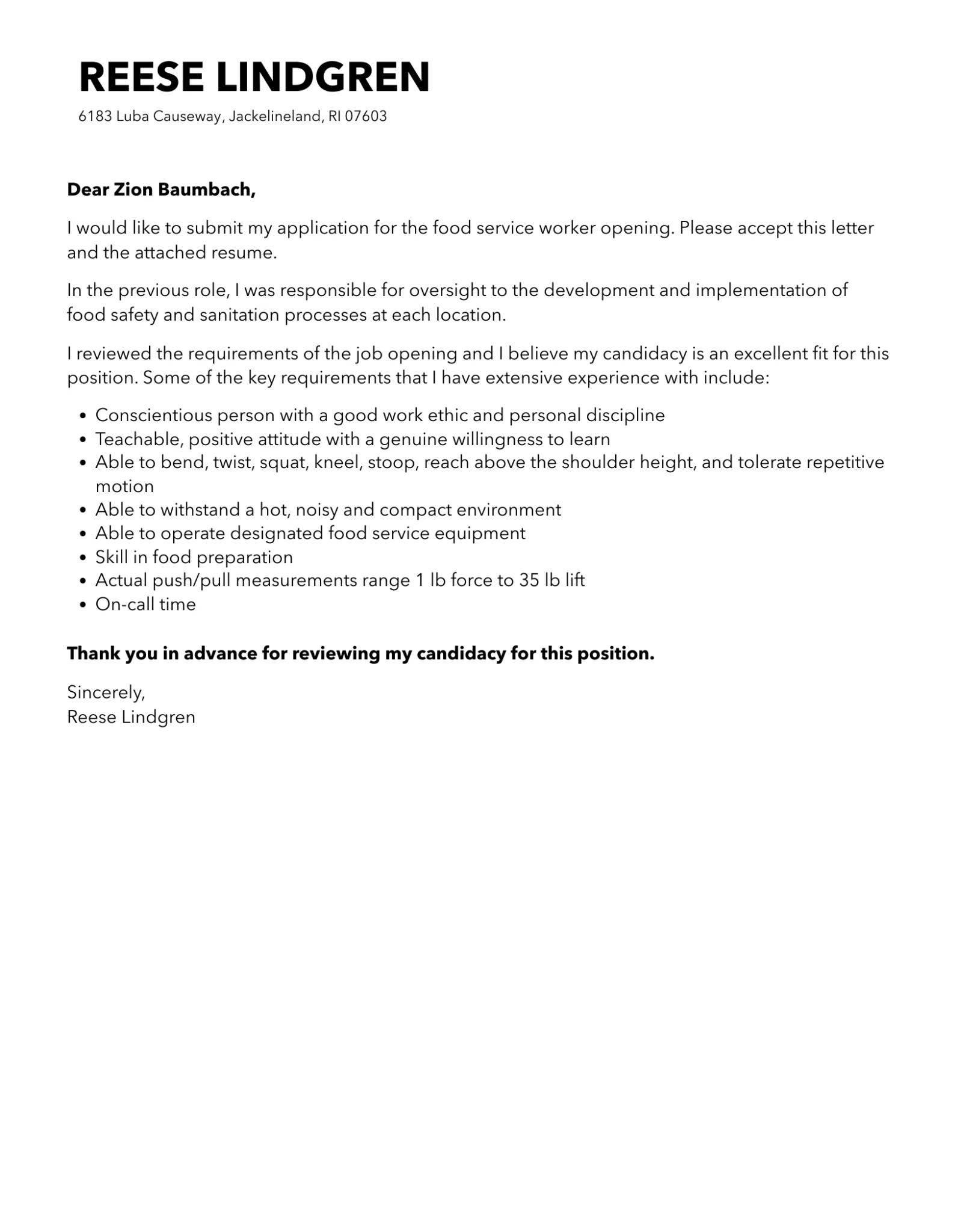
Header Section
The header of your Food Service Director cover letter should include essential information that allows the employer to easily identify you and contact you. This section sets the tone for the rest of the document, so it’s important to get it right.
Your Contact Information
At the top left (or left-aligned) of your header, include your full name, address, phone number, and email address. Ensure your email address is professional and includes your name, not a nickname or other casual identifiers. Double-check that all contact details are accurate and up-to-date. This will allow the hiring manager to easily reach you to schedule an interview.
Date
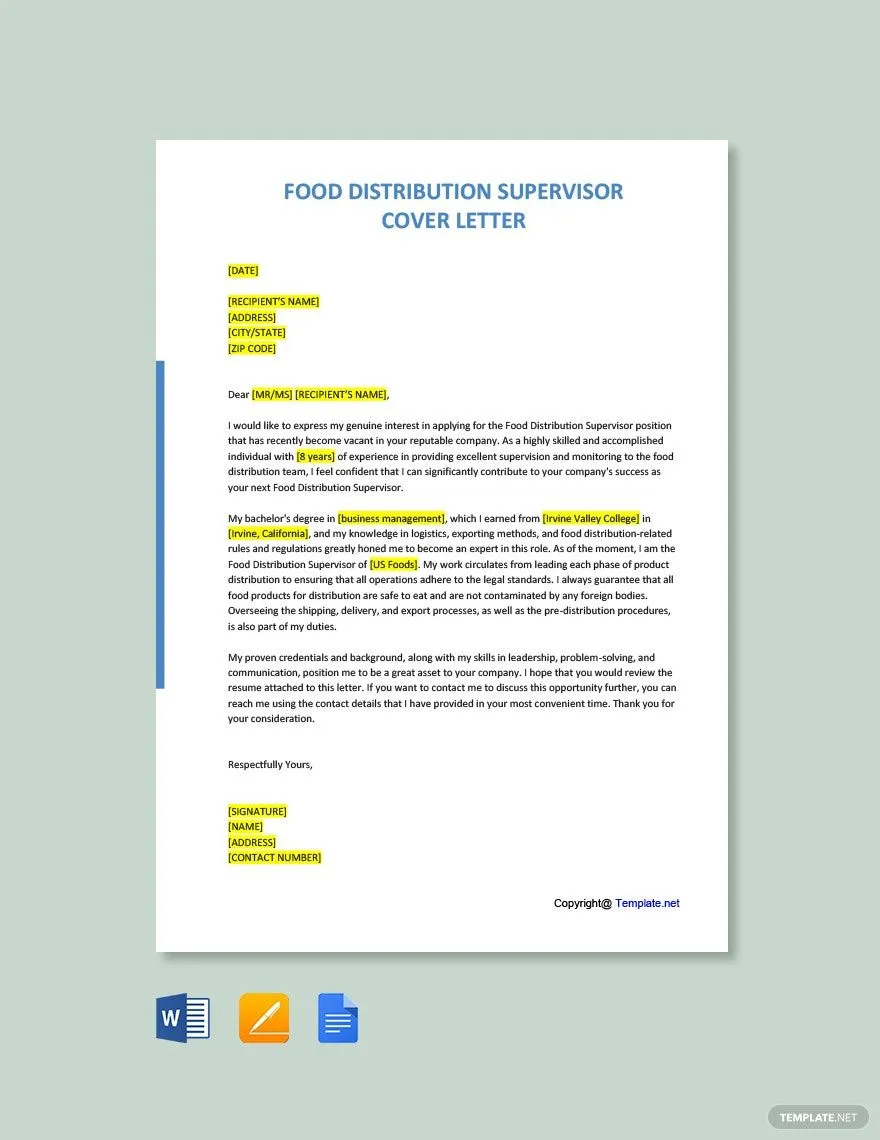
Directly below your contact information, on the same line as your contact details or on a new line, put the date you are submitting your cover letter. This date should be the current date, or the date you are sending the application materials. It’s a standard practice and essential for record-keeping by the employer.
Employer’s Contact Information
Under the date, include the hiring manager’s name (if known), their title, the company name, and the company’s address. If you do not know the hiring manager’s name, you can use the title of the hiring manager, such as ‘Hiring Manager.’ If you do not know their name, make sure to find out before the interview. Researching the hiring manager can show you are thorough.
Salutation
The salutation is your greeting. Use ‘Dear Mr./Ms./Mx. [Last Name]’ if you know the hiring manager’s name. If you don’t know their name, a professional alternative is ‘Dear Hiring Manager’ or ‘Dear Food Service Director Hiring Team.’ Avoid generic greetings like ‘To Whom It May Concern,’ which can make your letter seem impersonal and less tailored to the specific opportunity. A personalized greeting shows you’ve done your research and are genuinely interested.
Body Section
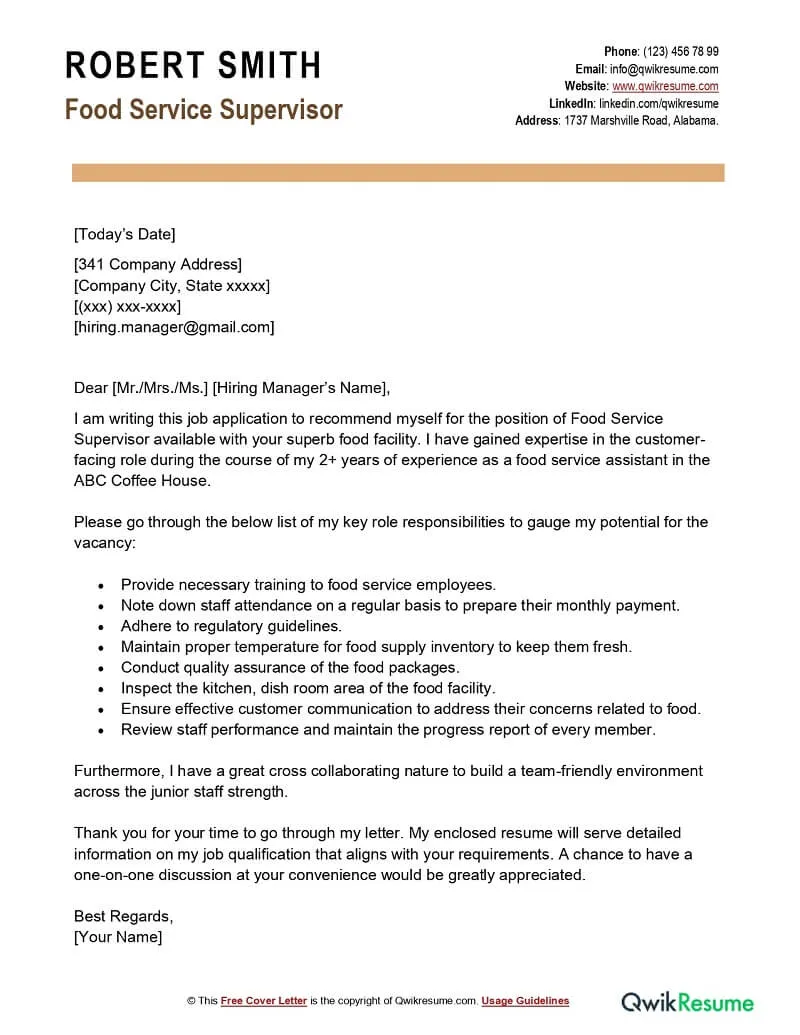
First Paragraph
Start with a strong opening paragraph that immediately grabs the reader’s attention. State the position you are applying for and where you saw the job posting (e.g., Indeed, company website). Briefly mention why you are interested in the role and the company. Demonstrate your understanding of the company’s mission or values and how your career goals align with the position. This section sets the stage for the rest of your cover letter. It should be concise and enthusiastic, creating a positive first impression. Show the hiring manager you understand the company’s needs and are genuinely interested in the opportunity.
Highlighting Your Skills and Experience
The body paragraphs should highlight your relevant skills and experience. Carefully review the job description and identify the key requirements. Then, select the most relevant accomplishments from your professional history and provide specific examples to illustrate how you have successfully met these requirements. Use the STAR method (Situation, Task, Action, Result) to structure your examples and provide context for your achievements. This will show the hiring manager what you can accomplish. Focus on demonstrating your skills in areas such as menu planning, budgeting, inventory management, staff training, and regulatory compliance. Tailor each paragraph to reflect the unique needs of the company and the specific responsibilities of the Food Service Director role.
Quantifiable Achievements
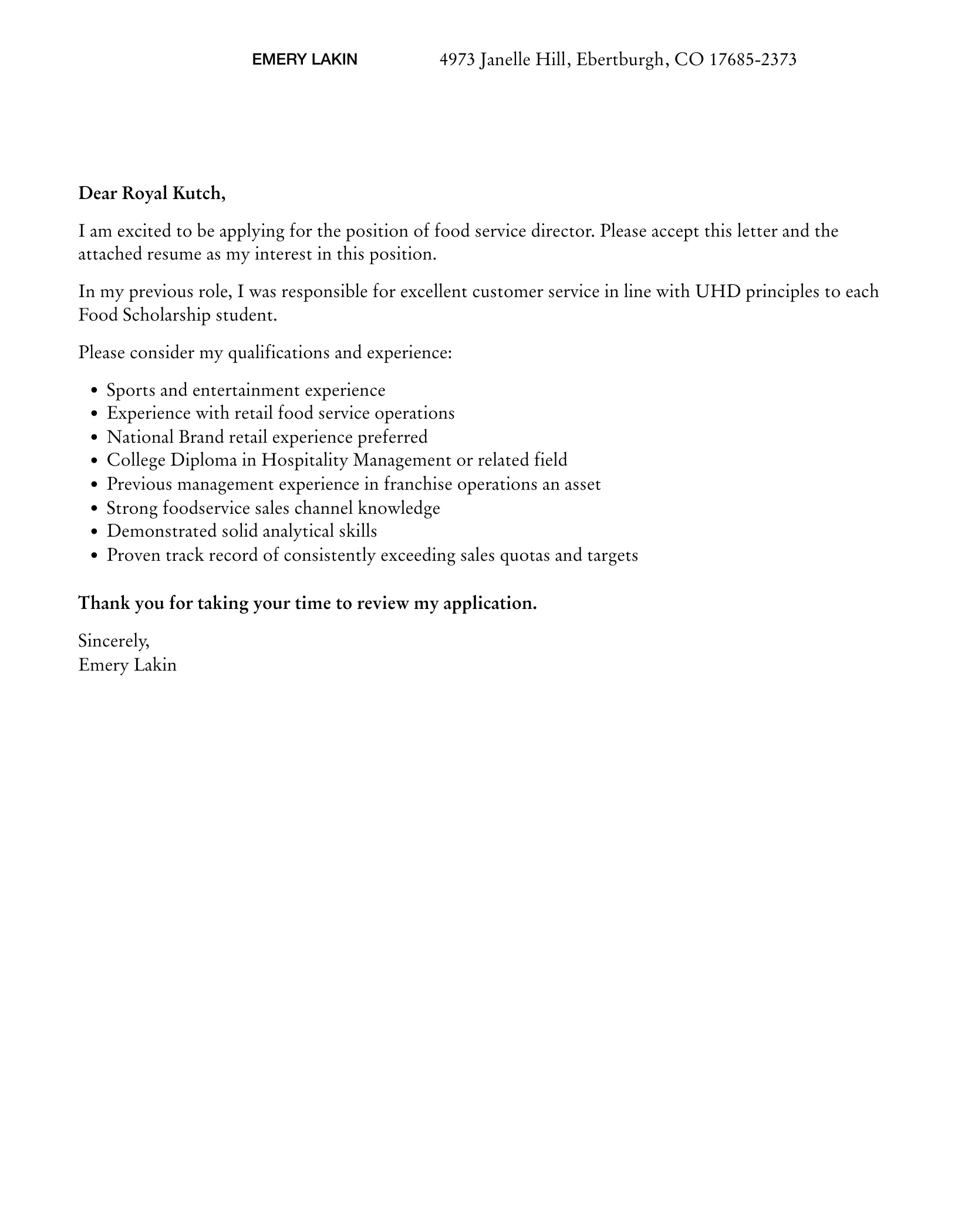
Quantify your achievements whenever possible. Instead of saying ‘Managed a team of employees’, use numbers and data to showcase your accomplishments: ‘Successfully managed a team of 50 employees, resulting in a 15% increase in productivity.’ Use metrics like cost savings, revenue growth, customer satisfaction scores, or reduction in errors or waste to demonstrate the impact of your work. Numbers make your claims more credible and show the tangible value you can bring to the organization. Providing verifiable data to support your claims helps you stand out. Include measurable data for better impact on the hiring manager.
Action Verbs
Use strong action verbs to describe your accomplishments and skills. Verbs like ‘managed,’ ’led,’ ‘implemented,’ ‘achieved,’ ‘developed,’ ‘improved,’ ‘streamlined,’ and ‘coordinated’ bring your experience to life and make your cover letter more engaging. Avoid passive language and clichés. Focus on the actions you took and the results you achieved. Choose verbs that accurately describe your role and demonstrate your proactive approach. Be specific with your verbs; instead of ‘worked with,’ say ‘collaborated with,’ or ‘partnered with.’ By using precise action verbs, you create a more impactful and dynamic cover letter.
Expressing Enthusiasm
Throughout your cover letter, express your enthusiasm for the position and the company. Demonstrate your genuine interest in the role by highlighting what excites you about the opportunity. Mention any specific aspects of the company’s mission, values, or culture that resonate with you. This shows the hiring manager that you are not just looking for a job, but are passionate about the field. Show that you are eager to contribute to the company’s success and grow within the organization. Your enthusiasm should be authentic and genuine, reflecting your genuine interest in the role and the company.
Closing Paragraph
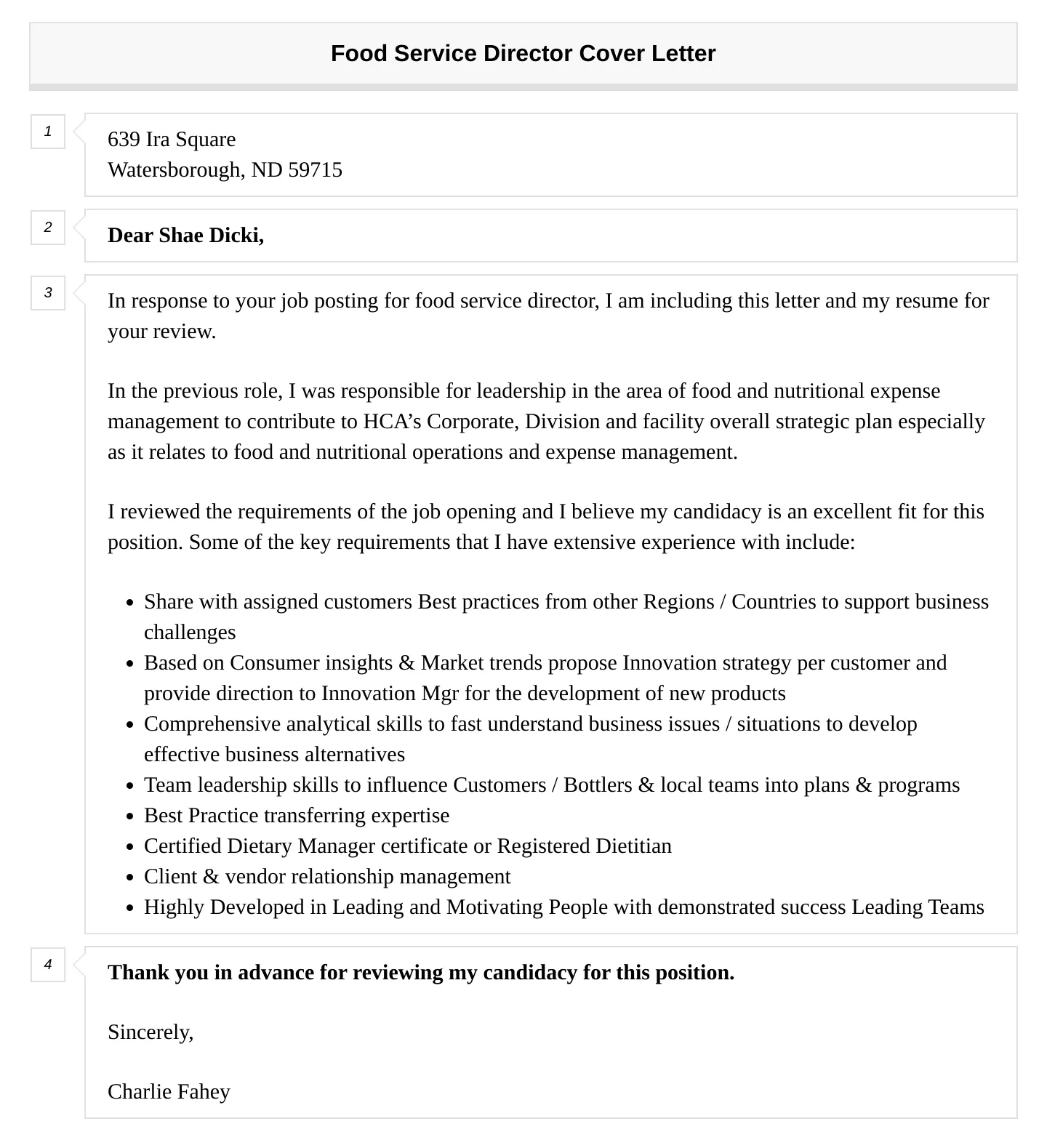
In your closing paragraph, briefly summarize your key qualifications and reiterate your interest in the position. Express your appreciation for the hiring manager’s time and consideration. End with a call to action, expressing your eagerness to discuss your qualifications further in an interview. This is a crucial moment to reinforce your interest and leave a positive impression. Ensure that your final words are professional and demonstrate your readiness to move forward in the hiring process.
Call to Action
Include a clear call to action. State your availability for an interview and express your desire to learn more about the opportunity. For example, ‘I am available for an interview at your earliest convenience and would welcome the opportunity to discuss how my skills and experience can benefit your organization.’ You can also thank the hiring manager for their time and consideration. A strong call to action prompts the hiring manager to move to the next step in the hiring process. It shows your proactive attitude and keen interest in the position.
Formatting Your Cover Letter
The formatting of your cover letter is essential. Good formatting makes your letter easy to read and professional in appearance. A well-formatted cover letter will not only demonstrate professionalism but also reflects well on your attention to detail, which is an essential skill for any Food Service Director. Make sure the cover letter is visually appealing.
Font and Font Size
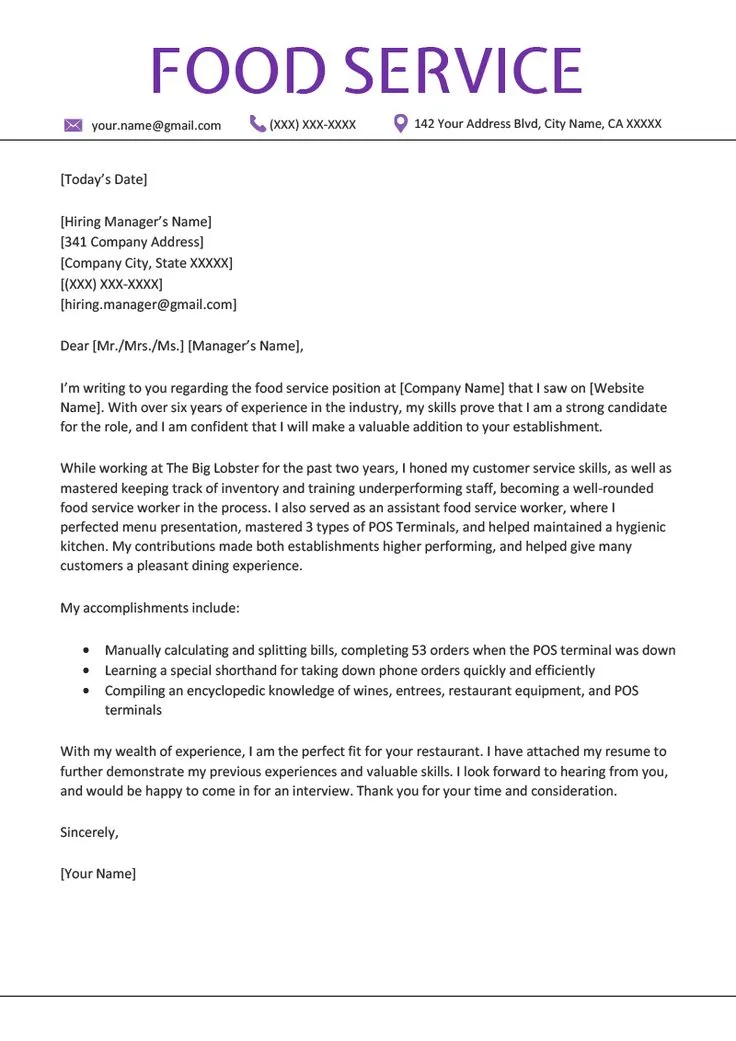
Choose a professional and easy-to-read font, such as Times New Roman, Arial, or Calibri. Maintain a font size between 10 and 12 points. This ensures your cover letter is readable without appearing too small or too large. Consistency in font choice throughout your cover letter demonstrates attention to detail. A clear and legible font and font size are essential for readability.
Margins and Spacing
Use standard one-inch margins on all sides of your cover letter. Maintain single-line spacing between lines within paragraphs and add a blank line between paragraphs. These formatting choices create enough white space to make your cover letter look clean and easy to read. Proper spacing ensures that the text is easy to follow and prevents the cover letter from appearing cluttered. This contributes to a professional and polished appearance.
Proofreading and Editing
Proofread your cover letter carefully for any errors in grammar, spelling, and punctuation. Errors can undermine your credibility. It is important to make sure you are providing high-quality work, which will help the hiring manager view you as reliable. Ask someone else to review your cover letter as well, as a fresh pair of eyes can often catch mistakes that you might have missed. Check for consistency in formatting, language, and tone. A well-edited cover letter demonstrates your attention to detail and commitment to producing high-quality work. Errors give the impression that you are sloppy or careless.
Best Practices for a Food Service Director Cover Letter
Tailoring Your Cover Letter
Always tailor your cover letter to each specific job you apply for. Avoid using a generic cover letter. Review the job description carefully and customize your letter to match the required skills, experience, and qualifications. This will highlight your suitability for the role. Show that you understand the company’s needs and are specifically interested in the opportunity. Use the job description to guide your selection of relevant skills and accomplishments. Demonstrating that you have taken the time to tailor your letter shows the hiring manager your genuine interest.
Keywords
Incorporate relevant keywords from the job description into your cover letter. This helps the hiring manager quickly identify that your qualifications meet the requirements. Use keywords naturally within the text. Overusing keywords can make your letter sound robotic. Keywords also help the applicant tracking systems (ATS) used by many companies to screen applications. Identify and use important keywords to show that you are the candidate they want.
Reviewing the Job Description
Carefully review the job description before writing your cover letter. The job description will provide valuable information about the role’s requirements, responsibilities, and preferred qualifications. Understanding the requirements allows you to tailor your cover letter to specifically address the job’s needs. Make sure to highlight your relevant skills, experience, and accomplishments. By focusing on the requirements, you can create a targeted cover letter. Match your qualifications to the description to showcase you are the right fit for the job.
Common Mistakes to Avoid
Typos and Grammatical Errors
Typos and grammatical errors can make your cover letter appear unprofessional. Always proofread carefully and use a grammar checker to identify and correct any errors. Incorrect grammar is viewed negatively by a hiring manager. A well-written, error-free cover letter demonstrates your attention to detail and professionalism, while errors can create a negative impression. A polished and accurate cover letter shows that you are reliable and meticulous.
Generic Cover Letter
Avoid using a generic cover letter. Tailor your letter to each job you apply for. A generic cover letter suggests that you did not take the time to understand the specific requirements of the role or the values of the company. Generic cover letters are easy to spot and can give the impression that you are not truly interested in the position. Always customize your letter to highlight your relevant skills and experience and demonstrate your genuine interest in the role. This shows that you are proactive, and eager to contribute to the company’s success.
Lack of Enthusiasm
Show enthusiasm for the position and the company throughout your cover letter. Express your interest in the role, and your excitement. If you lack passion, the hiring manager will think you aren’t truly interested. Make sure your enthusiasm is genuine and demonstrates your eagerness to contribute to the company’s success. Be sure to make sure you are showing the right amount of personality.
